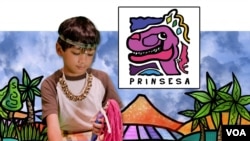A group of guys sitting around watching boxing on television is kind of the quintessential macho thing to do. In a short movie called Prinsesa, that’s what a 28 year old Filipino-American father named Rey is doing with two buddies, and also taking care of his young son and daughter while Mom is out. An earthquake suddenly hits, plunging them all into darkness and making the children very scared.
After finding some candles, Rey tries to calm them down with a story based on a traditional dance in the Philippines called a singkil. It is the tale of a beautiful princess in the forest who is the envy of all around her, and a heroic warrior prince.
Rey’s son, six-year-old Jojo, is entranced, saying he wants to be the princess with beautiful long hair, wearing a necklace of bells around his neck. Jojo starts to dance, imagining himself as the princess. The father’s two friends, now without their sports fix on television, get very irritated watching the boy’s actions and belittle their host about the boy’s tendencies.
Rey orders them to get out of the house and is forced to question his own parenting skills. Prinsesa writer and director Drew Stephens tells this seemingly simple story of a sensitive matter in a most captivating way. Live actors are animated into backgrounds with vivid color for the singkil portion of the story.
VOA’s Ray Kouguell spoke with Stephens, who lives in San Francisco, about how he came up with the idea of making a film about gender identification and using Philippine culture to make the point.
STEPHENS: I married into a Filipino family. More than 20 years ago. Of course, I fell in love with the culture including their rich culture of epic storytelling. By far my favorite Filipino traditional tale is the singkil. It’s a dance actually and it tells about a princess who dances through an earthquake. She’s with her loyal entourage and they carefully dance around the dangerous, falling bamboo trees and the Kulintang gongs and the drums are echoing through the forest and it’s just really powerful and I knew that someday I wanted to share the singkil in a film. But I just really needed a modern day story to pair with the traditional backdrop.
KOUGUELL: What familiarity did the actors and actresses you used have about the traditional story and dance?
STEPHENS: I knew that I had some dancers who could play the princess and her entourage but the actors all came from Bindlestiff Studio which is a Filipino performing arts group in San Francisco and they had never danced. So Patrick Silvestre who plays the father had never danced the singkil at all and had to learn it for this film, as did both the boy and the girl.
KOUGUELL: How did you decide to combine the singkil with gender identification?
STEPHENS: Singkil is thought to have originated in the Mindanao region of the Philippines, specifically of the Maranao people around Lake Lanao. And one of the interesting things about that is that it was originally danced all by women that would play all the roles whether male or female. When the parents tell traditional tales that go back hundreds and hundreds of years, do modern day children see themselves in these traditional tales and what if they don’t, can we change the tales without losing our cultural identity?
KOUGUELL: Is the Filipino-American community especially sensitive to the gender identification issue?
STEPHENS: There’s a term called “Backla” which is typically a very effeminate boy so I think that Filipinos in general are open to that concept but if you spoke to people raised within that culture you’ll find strongly defined gender roles. Especially men are expected to act a certain way.
KOUGUELL: Is the film offering advice on parenting skills and dealing with identity conflict?
STEPHENS: What I tried to do was portray the confusion from the father’s perspective and I think the writers made a conscious decision not to tell people how to feel, what to do or how to parent but to show the confusion and indecision that some parents might face. In fact, if people leave the theatre and say, “Hmm, that’s not how I would do it” or “what would I do?” then we’ve succeeded with what we wanted to do with this film. So yeah, I think the overall message is that we really want to embrace all of our children and frankly, my point was to salute the parents who do just that. They’re like superheroes to me.
KOUGUELL: Stephens’ film Prinsesa uses an all-volunteer crew of 40 people and is beautifully complemented by an original score from Emmy award-winning composer Mitchell Covington. While the film does raise questions about non-gender conforming children, there are answers to fit any parent-child relationship. They are all matters of love and acceptance. Prinsesa offers a visually unique look, one that has already been successful at independent film festivals in the United States and Mumbai, India.









